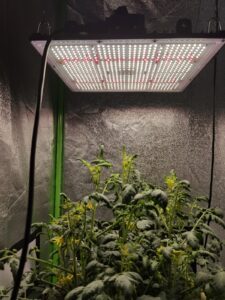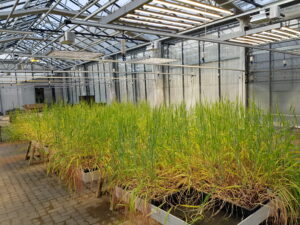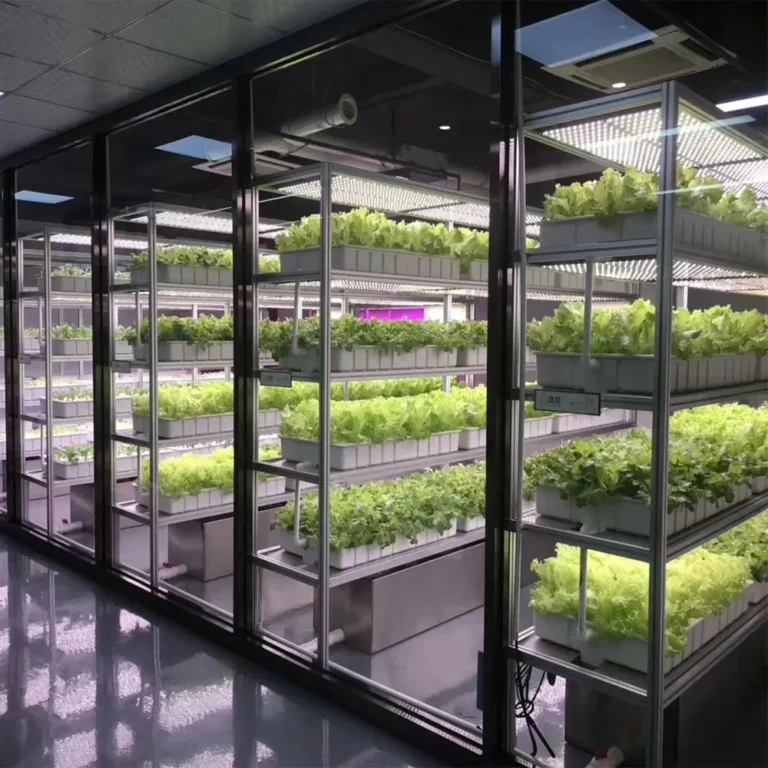Table of contents
ToggleWorth knowing about plant grow lights
Understand glow lights and all the concepts
If you have been researching which LED lamp to choose as a grow light for your plants, you have probably been bombarded with a large number of measurements that the various plant lighting manufacturers use to market their products. Some of the terms and concepts that you have probably seen are Watt, Lumen, LUX, PAR, PPF, PPFD and photon efficiency.
Although all of these concepts relate to lighting, only a few of them are truly relevant and important metrics for a lighting system for plants. The purpose of this article is to define these terms and concepts, as well as correct some of the most common misunderstandings. In addition, we will also help you understand which measurements apply to lighting systems/grow lights and which do not
What is grow light?
Before we dive deep into all the advanced concepts, it is important that you first have a basic understanding of what grow lights are. You can read this article if you would like to know more about it, otherwise here is a short summary of what grow lights are and what they are used for.
Grow light: grow light, grow lights, plant lamps, plant light are all different names for the same thing. In short, grow lights are artificial light for the purpose of stimulating plant growth. Here at plantelys.dk we only have grow lights with LED drivers. LED is the best type of grow light technology on the market, as it is both the most power-efficient and the most durable.
The very point of grow lights is that you can either supplement the natural sunlight or completely replace it. In this way, you can become the primary contributor to the plant's photosynthesis. With a grow light lamp, you can therefore grow plants completely without the help of the sun, both inside the living room, the kitchen or in the basement, even in winter.
What is LUMEN and LUX
First, it is important to understand that plants and humans perceive light very differently from each other. Humans and many animals use something called photopic vision. Photopic vision allows the eye to perceive light and color as long as it is not dark and there are well-lit conditions (eyes work differently when it's dark). Lumen is a unit of measurement based on a model of the light sensitivity of the human eye under well-lit conditions. The model is called the photopic reaction curve, it can be seen below.

As you can see, the photopic response curve is bell-shaped, showing how humans are much more sensitive to green and yellow light than to blue or red light. LUX and foot candle light meters measure light intensity (using Lumens). LUX measurements a typically used for commercial and residential lighting. The only difference between the two is the unit of area they are measured over (LUX uses lumens/m2 and foot candle uses lumens/ft2). Using a LUX instrument to measure the light intensity in your plant lighting system will give different measurements depending on the spectral composition of the light source - even if the same light intensity is measured on a PAR instrument.
The fundamental problem with using a LUX meter to measure the light intensity of a grow light is the underrepresentation of blue (400 – 500 nm) and red (600 – 700 nm) light in the visible spectrum. The human eye is not particularly efficient at perceiving light at these wavelengths, however plants are highly efficient at using red and blue light to drive their photosynthesis. This is the reason why lumen, LUX and foot candle should not be used as a measurement of lighting in horticulture and home cultivation "setups". Here it is much more advantageous to measure PPF or PPFD. Lumen and LUX are therefore NOT relevant units to use when we talk about grow light and efficiency!
What is Ra and CRI
CRI is an acronym for "color rendering index". The purpose of CRI is to assess the quality of a light source in relation to color reproduction. A CRI light source test takes place by the light source illuminating a specific index of test colors (TCS), these colors share the designation Ri, where the i stands for the place of the test color in the index.
Typically 8 test colors are used, these for R1, R2, R3 and so on, all the way up to R8. The test of the light source's color accuracy consists of 8 parts. There is therefore one test per color in the index.
The 8 individual tests then take place by illuminating one of the test colors with the light source, and using an advanced device to compare how exactly the test color appears under the light source with how it would appear lit by natural daylight, or an incandescent bulb. (What it is compared to depends on the color temperature)
This accuracy rating is then given a score between 0 and 100, here 100 is the most accurate and zero is the least. If the test color being tested, for example, was the color R4, and there was a very high color rendering, it could get a "rendering score" of R4-92
So 8 different numerical values are given during the test, all of which are between 0 and 100. The Ra value stands for "rendering-average", it is therefore an average of all 8 scores. It is then this value that is used to describe a lamp's general color reproduction accuracy. It is important that your light sources in the home have a high Ra value, as otherwise colors will start to look wrong and flat.
However, there is a problem with this way of judging the accuracy of light sources. There are none of the 8 test colors that are red. Red is a very difficult color for a lamp to reproduce correctly, and if the lamp is bad at red, skin tones and wood will look strange. Sellers of poor quality light sources can therefore make them appear better than they are by only testing the 8 colors.
Here at plantelys and at our sister company sunflux.dk, we therefore use what is called extended CRI. Tests conducted with extended CRI instead have 14 test colours, from R1 to R14. Here the colour R9 is a strong red colour. A lamp with a good Ra score in the extended CRI scale will therefore be an accurate lamp. So you can trust the Ra values on this page!
A good Ra score is very important for people, but for grow lights for plants a good Ra score is almost irrelevant. Plants' photosynthetic receptors do not function like our eyes, so for plants there are other things that you should prioritize higher. The PPFD of the grow lamp will, for example, be much more important to pay attention to than the Ra value if you are trying to find a lamp that is optimal for plant growth.
If you have any questions about Ra and CRI, you can always contact our team of experts here
What is PAR
PAIR (Pphotosynthetically Active Radiation) is photosynthetically active radiation. PAR grow lights are grow lights with wavelengths within the visible range from 400 to 700 nanometers (nm), it is these wavelengths that best drive photosynthesis. PAR is a widely used (and often misused) term related to plant lighting. PAR is NOT a measurement, unit or “metric” such as feet, inches or kilos is. Rather, the measurement defines the type of light needed to support photosynthesis.
The amount of light and its spectral composition are important measurements of the quality of PAR light. A quantum sensor is the primary instrument that can be used to quantify the light intensity in a horticultural lighting system. These sensors use a special optical filter to create a uniform sensitivity to PAR light. The measurements can be used in combination with a light meter to measure instantaneous light intensity. Or they can be used with a data logger to measure cumulative light intensity over time.
If you want to know more about PAR grow lights, we have a entire article dedicated to the topic.
What is PPF
PPF is photosynthetic photon flux. PPF measures the total amount of PAR light produced by a lighting system every second. This measurement is made using a specialized instrument called an integrating sphere.
One integrating sphere is a very large sphere, with light sensors all over the inside. To carry out the test, insert the PAR grow light into the sphere as shown captures and measures all the photons emitted by a grow light. The unit used to express PPF is micromole per Second (μmol/s).
This is probably the second most important way to measure a horticultural lighting system. However, it often happens, for unknown reasons, that most lighting companies do not state the PPF on their grow lights. It is important to note that PPF does not tell you how much of the measured light actually lands on the plants and is not just wasted by flying into the room. But it's still missing an important measurement if you want to calculate how effective a light system is at creating PAR.
What is PPFD
PPFD is photosynthetic photon flux density. PPFD measures the amount of PAR that actually arrives at the illuminated plants, or as a scientist might put it: "the number of photosynthetically active photons falling on a given surface every second". PPFD is a 'point' measurement of a specific location on your plant's leaves and it is measured in micromoles per square metre per second (μmol/m2/s).
If you want to find out the correct light intensity for a lamp over a specified grow area (eg 20cmx 20cm), it is important to average several different PPFD measurements from different locations on the grow area. Lighting companies that only publish PPFD in the center of a coverage area grossly exaggerate their fixture's true light intensity. A single measurement therefore does not tell you much, as the "cone of light" of grow lamps is generally brightest in the middle, with decreasing PPFDthe light levels when the measurements are taken towards the edges of the coverage area. (Caveat Emptor: Lighting manufacturers can easily manipulate PPFD data. )
To ensure that you get the true PPFD values over a defined growth area, the following should be published by the manufacturer: measurement distance from light source (vertical and horizontal), number of measurements included in the average, as well as the min/max ratio). Here at plantelys.dk, we strive to always publish the average PPFD over a defined growth area, as well as all the necessary data, for the recommended mounting height for all our grow light sources.
PPF Efficiency
Photon Efficiency refers to how efficient a plant growth lighting system is at converting electrical energy into PAR photons. Many less good manufacturers and resellers of grow lights use total electrical watts or watts per watt. Square feet/meter, as a measure to describe light intensity of their grow lights. However, these measurements really don't tell you anything, since watts are a measurement that describes electrical input, not light output.
If the light's PPF is known along with the input power, you can calculate how efficient a horticultural lighting system is at converting electrical energy to PAR. As a reminder, the unit for PPF is μmol/s, and the unit for measuring watts is Joules times second (J/s). To find the efficiency, you need to calculate how many PPFs come per W. The calculation therefore becomes (μmol / s) / (J/s). As you can see the seconds in the numerator and denominator cancel each other out, and the unit becomes μmol/J. This number gets higher the more efficient a grow lighting system is at converting from electrical energy to photons from PAR.
What is Watt?
As just touched on in the chapter on PPF efficiency, Watt is not a directly relevant measurement, at least not for your plant. However, the amount of watts your grow light uses is still very important to you. Watt is the input power to the lamp. It therefore only says something about how much power it uses. But this is actually extremely relevant on two counts
1. Price
2. Heat dissipation
The unit Watt for a lamp is given by the number of joules which the lamp uses every second. When you have to pay your electricity bill to your electricity company, you must pay based on how many kWh (kilo watt-hours) you have used. A kWh is one thousand Wh (watt-hours). A Wh is one watt over one hour.
If you buy a halogen bulb or fluorescent grow lamp, your annual electricity consumption in kwh will be high, and your electricity bill will therefore be expensive. Plus the high power consumption will emit a lot of heat, it may then be necessary to actively cool your "growing room". You can try playing with the calculator below to see how much money you can save on your electricity bill by buying a more efficient bulb with a lower power consumption.
Watt (J/s) and daily switched-on hours for annual electricity price:
Wattage of the lamp:Number of daily switched-on hours:
Your electricity price per kWh (typically between DKK 3-4):
Result: ?
As you can see, it really pays off to buy a power-efficient LED, rather than a halogen bulb or fluorescent grow lamp.
Daily light integral
DLI stands for daily light integral, or in Danish integrated daily light. DLI is highly associated with PPFD. Just like PPFD shows how many photosynthetically active photons hit a given plant per plant. square meter per second, DLI shows how many photosynthetically active photons hit a given plant per square meter per day. DLI is therefore very relevant in plant cultivation. If you use an artificial light source, with a constant PPFD, it is very simple to calculate the DLI.

Many plants have a certain amount of DLI they need to thrive. If you want to give your plants the correct amount of light, it therefore makes good sense to try some DLI calculations. As mentioned earlier, the unit for PPFD is micromole per Square meters per Second (μmol / m2 / s). In order to calculate DLI at constant PPFD, we simply have to convert the number to have the unit micromole per Square meters per day (μmol / m2 / s). Since the micromoles will end up being very high, it is also converted from μmol to Mol. One Mole is 1,000,000 μmol. You can therefore calculate DLI with this formula:
DLI = PPFD x (t) / 1,000,000
DLI = PPFD x (3600 x Hours) / 1,000,000
You are now able to calculate DLI! In our article “How many µmol/PPFD does my plant need to thrive?” you can find more information about DLI, you can also try our built-in calculator in the article!
If you are trying to calculate the DLI of a plant under either the sun, or another varying light source, the enrichment process is much more complicated. You can read this technical article from licor, if you want to learn how to calculate DLI, based on a sensor and simplified integration calculation.
CONCLUSION
In order to invest in the right lighting system for your home growing project or professional horticulture that can meet all your needs, you first need to know about PPF, PPFD and photon efficiency. That is almost all that is needed to be able to make well-informed purchase decisions. However, these three metrics should not be used as the only variables on which to base a purchase decision. Indeed, there are several other variables that may be relevant, such as form factor, dispersion angle, design and utilization coefficient (CU), which must also be considered. See ours large selection of grow lights for inspiration.

You should therefore use all these many factors in combination if you want to guarantee that your choice of grow light will be the one that is optimal for you. If you want a nice grow light, but would like to save some money, you can visit ours category for plant lights on offer.
So remember PPF, PPFD and photon efficiency are the real measurements. These are the measurements used by researchers and all leading grow light nurseries. If a company does not use these measuring units in their product descriptions, it can signal that they are either untrustworthy or not completely competent in plant lighting, so you should consider buying your grow lamp from somewhere else.
The three important questions that you must ask yourself when you are examining grow lights for potential purchase are therefore as follows:
- How much PPF PAR does the plant lamp produce?
- How much PFD PAR from the fixture is actually available to the plants?
- How much energy is converted and available as PAR light for your plants? (PPF Efficiency)
If you need help or want to know more, you are more than welcome to contact us team of experts. We can help you with everything from fertilizer and plant lights, to kitchen and underwater fish farm lighting.





